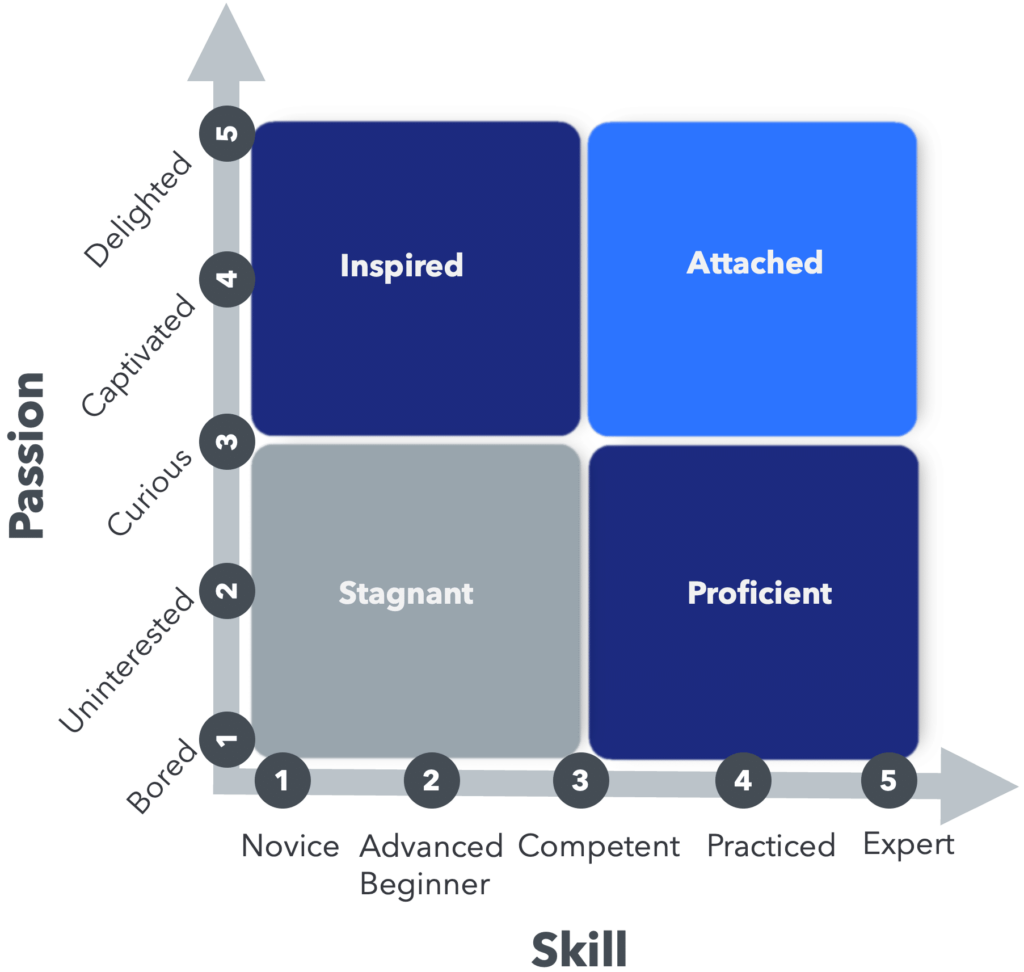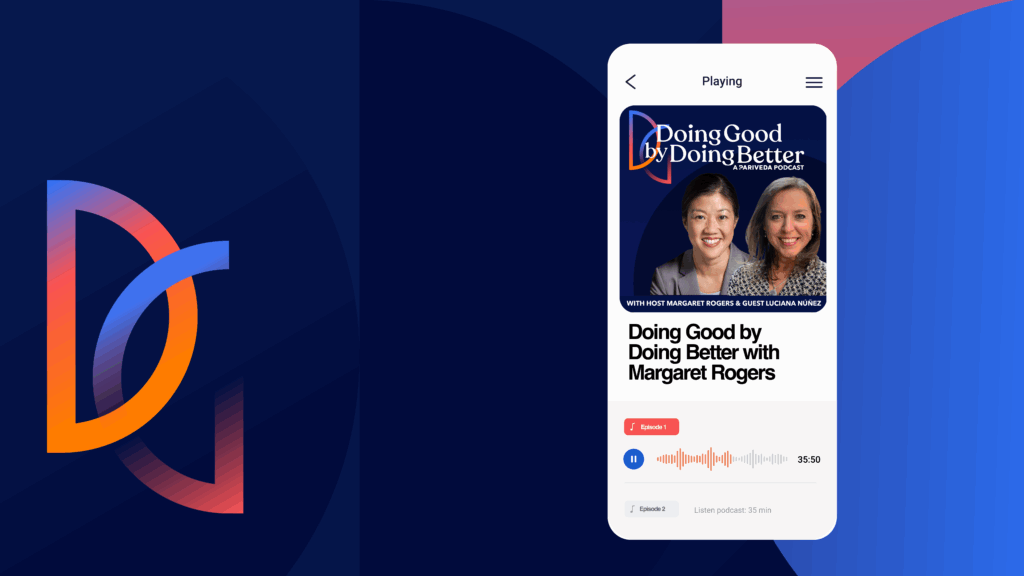FRAMEWORK
Finding productivity through meaningful work
- To increase employee engagement and maximize productivity, organizations can provide the right tools to help employees find attachment in their roles through fulfilling individual and group purposes.

The cost of disengaged employees
Disengaged employees are a significant financial drain, yet companies continue to spend over $100 billion on employee engagement efforts every year. Even with this investment, their efforts have not been effective, as the number of engaged employees has remained below 25% for years. This ends up costing companies even more money as disengaged employees have around 18% lower productivity, which results in an average of 15% lower profitability for the company.
Disengaged employees have
Employee engagement has remained at or below 30% for years4
Lower Productivity1
Lower Profitability1
American companies spend over $100 billion per year on employee engagement efforts3
(Gallup)
Evolving employee expectations
So, why are we seeing this continued level of disengagement from employees? One reason is because their relationship with and expectations of their workplace have changed over generations.
Employees no longer view their jobs as a way to collect a paycheck but as a way to provide value and make an impact. As more and more employees reflect on their purpose, they seek roles that align with their values and allow them to live that purpose.
Affective commitment is influenced when an employee finds value, joy, and belief in what they do, which has four times the power to affect performance and increase discretionary effort (Harvard Business Review)
Current efforts to improve employee engagement have failed because they don’t address the emotional needs of employees’ desire to find fulfillment in their work. However, if an organization can engage their employees at a higher level, they will see higher productivity.
Higher Profitability1
Higher Productivity1
Higher Customer Loyalty1
Addressing purpose with the Employee Attachment Framework and Assessment
To engage employees at a higher level and cultivate greater productivity, businesses need to help employees manage individual and group purpose. We begin to see a polarity between these purposes developing that organizations must address. A polarity is an interdependent pair of values or strengths that are both needed over time for a healthy, integrated, thriving self/organizational system. Managing the polarity of individual (the employee) and group purpose will connect the employee to the group in a meaningful way that also fulfills their individual purpose. As a starting point, it’s important that individuals on the team share the same values as the group and that the company purpose is well-defined and understood throughout the organization so that there is a common understanding.
In the case of the group and individual purpose polarity, there are risks if an employee is pulled too strongly to one side. If there is too much emphasis on their individual purpose, this has a negative impact on the group’s performance as they can lose sight of the group’s goal. If there is too much focus on the group purpose, though, the employee can detach from the group by becoming overwhelmed with work and feeling burnt out.
The Employee Attachment Framework
To manage the polarity of individual and group purpose, organizations need the right processes and tools in place. Pariveda’s Employee Attachment Framework helps companies support employees in managing the purpose polarity and increases employee engagement.
Knowing that the fulfillment of purpose is what employees are looking for and what drives engagement, and that purpose comes from the impact an individual has along with their interests, this framework gives managers the tools to manage these levers with the structure, direction, and culture of the team. This framework is implemented at the team level and involves each individual, with the manager acting as the facilitator of the assessment, the translator of the results, and the multiplier of engagement across the team. The manager works with each individual on their team to assess their engagement using a tool called the Attachment Assessment.
The Employee Attachment Assessment
The Employee Attachment Assessment evaluates an employee’s responsibilities against the components of purpose.
Using the Attachment Assessment, employees can better understand how their role and responsibilities align with the drivers of engagement, passion, and skill – what motivates an individual – and what makes up their purpose. These components drive the employee’s growth, attaching them to a higher level of motivation. Maximizing these components increases an employee’s engagement level and, ultimately, their productivity.
The Attachment Assessment identifies four different states of engagement that employees experience, which are important to understand.
- Stagnant – An employee is actively disengaged because they are not doing something they can succeed in, and they have no passion for what they’re doing to the extent that they are uninterested.
- Inspired* – This is when an employee is really interested in what they’re doing but may not have the skills yet to succeed or thrive in their role.
- Proficient* – On the other hand, if an employee is highly skilled but finds their work too easy or has lost the sense of why their role matters, they are in the Proficient state.
- Attached – When an employee is in an Attached state, they produce at a higher level and are passionate about what they are doing. When they are attached, they feel connected to the purpose of the group and their individual purpose because their work is grounded in things they care about, excel in, and are making an impact.
*The Proficient and Inspired states are still levels of being engaged, but not to the fullest, which means productivity is still being lost.

Based on the assessment’s output, managers work with employees to identify actions that, when implemented, will increase employee engagement and increase the team’s performance. This tool is integrated with an organization’s existing performance review processes to ensure engagement is assessed at regular intervals to improve overall engagement in the next assessment.
Creating a plan for increased attachment and engagement
Managers play a critical part in helping employees fulfill their unique purpose while realizing their contribution to the group purpose so that all parties can thrive.
Using the Employee Attachment Framework and Assessment, managers can regularly assess engagement levels with their teams and, based on each employee’s position on the attachment scale, collaborate with them to develop personalized plans for increasing their level of attachment and engagement.
Plans will vary based on where the employee is and where the employee is looking to go, and they could include things like role exploration, purpose activation workshops, job crafting exercises, or team building. Employees are moving between these quadrants of attachment throughout their careers.
They don’t always move in a linear order, either. For example, someone can move from Inspired to Proficient without going into Attached, but these tools help them move from where they currently are closer to the Attached state.
With this tool, organizations can minimize the larger ebbs and flows of engagement, catch potential disengagement before it happens, and keep employees highly engaged. Measuring the movement of engagement allows teams to maintain productivity and decrease engagement variability by proactively managing it.
Getting started with employee engagement
Using these tools, organizations can increase employee engagement and, ultimately, productivity by building a strategy for managing engagement. At the end of the day, engagement is a people problem, and people are unique, just like organizations and teams, so each will require their own approach.
The good news is you can start small and still see the impact. Rolling out an engagement strategy to the entire organization can be overwhelming. Starting small will help uncover insights that can be used when it is implemented at scale while still harnessing the value of higher engagement and productivity to be brought to the teams that implement it by helping their members manage purpose through attachment.
In the end, higher employee engagement is a strategic asset and a competitive advantage for companies to succeed, so why not enable those most affected with the right tools to improve it?





















